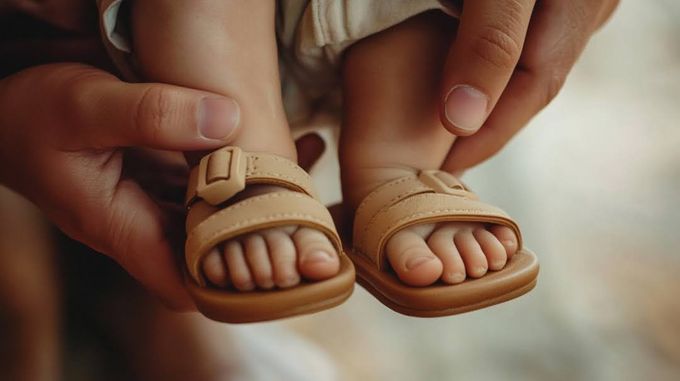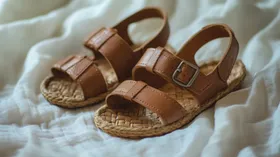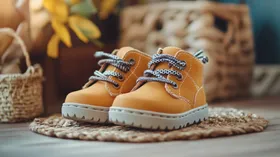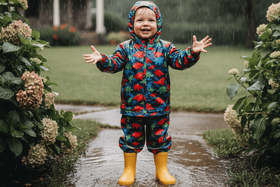How Should Sandals Fit Toddlers? Step Into Summer
Summer fun, safe and sound: Tips for choosing the best-fitting sandals for your toddler
Published December 8, 2024

Summer is here, and for toddlers, that means endless adventures, playground escapades, and beach days. But before your little one starts exploring the world, one crucial item can make or break their summer fun: the perfect pair of sandals.
Getting the right fit isn't just about comfort—supporting your toddler's foot development and ensuring they can play safely and confidently. Let's find out how.
» Make summer adventures more enjoyable with sandals that fit just right
Why Sandals Are Great for Toddlers
Toddlers' feet grow rapidly, and sandals offer greater flexibility to accommodate these growth spurts. Here are some other benefits of sandals for growing feet:
- Sensory Development: The open design of sandals allows toddlers to feel different textures and temperatures, stimulating their sensory development.
- Motor Skill Development: As toddlers practice putting on and taking off sandals, they develop fine motor skills and hand-eye coordination.
- Healthy Foot Development: Sandals with proper support can help promote healthy foot development, especially in the early stages of walking.
- Breathability: Sandals offer excellent breathability, keeping little feet cool and dry, especially during warmer months. This helps prevent moisture buildup and reduces the risk of fungal infections.
- Flexible Fit: Adjustable straps and soles allow for a customised fit, accommodating growth spurts and ensuring daily comfort.
» Little one taking their first steps? Find the best shoes for learning to walk
How Should Toddler Sandals Fit?
Properly fitting shoes are crucial for developing feet. Toddler sandals should have approximately a thumb's width of space between the child's longest toe and the sandal's front edge. This extra room allows for natural foot growth and prevents cramping while ensuring the sandal isn't so big that it causes tripping or unstable walking.
The sandal's width should comfortably accommodate the child's foot without pinching or leaving excess space. Adjustable straps are crucial, as they should:
- Secure the foot without creating tight pressure points
- Prevent the sandal from slipping off during active movement
- Allow for slight expansion as the child's foot moves and flexes
Always have toddlers try on sandals and walk around, checking for comfort, ease of movement, and secure attachment. Feet should be measured periodically, as toddlers' foot sizes change rapidly during early developmental stages.
» Check out the difference between regular and supportive shoes
How to Measure Your Toddler's Feet
To ensure a proper fit, measuring your toddler's feet is essential. Here's a simple method:
- Gather Supplies: You'll need a piece of paper and a pen or pencil.
- Prepare the Surface: Place the paper on a hard, flat surface like a tile floor.
- Position Your Kid: Have your child stand on the paper with their weight evenly distributed.
- Trace the Foot: Carefully trace the foot's outline, including the heel and toes.
- Measure the Length: Measure the longest tracing length from the heel to the longest toe.
- Consider Width: While length is important, consider your child's foot width. Some brands offer wider or narrower fits.
- Check Regularly: As toddlers grow quickly, measure their feet every few months to ensure a proper fit.
» Check out the difference between regular and supportive shoes
Top Features When Choosing Sandals
When selecting sandals for your toddler, consider the following factors to ensure comfort, safety, and proper foot development:
- Heel Support: A well-structured heel cup provides stability and prevents ankle instability. A firm yet gentle hold on the heel reduces the risk of slipping and twisting the foot, which can lead to discomfort and potential injuries.
- Toe Room: Ample toe room is essential for natural foot movement. It allows toes to spread and flex, reducing the risk of ingrown toenails and discomfort.
- Adjustable Straps: These are invaluable for a customised fit. They accommodate growth spurts and prevent blisters. A secure fit, especially around the ankle and forefoot, is essential for stability during active play.
- Arch Support: A supportive footbed promotes proper arch development and reduces the risk of flat feet. It helps maintain the natural shape of the foot and distributes weight evenly.
- Material: Leather is a classic sandal choice, offering durability, breathability, and excellent support. While synthetic materials might be more affordable, they often lack these qualities.
» Check out the best shoes with easy-to-use Velcro straps
Understanding Foot Variations
Not all toddler feet are the same, with some having naturally wider or narrower feet compared to standard sizing charts. Sandals with multiple strap adjustment options accommodate different foot shapes, preventing unnecessary pressure points and potential discomfort.
Additionally, consider your child's specific foot type. For toddlers with high arches, look for sandals with ample arch support to prevent discomfort and fatigue. On the other hand, those with flat feet may benefit from sandals with a supportive footbed to encourage proper foot development.
» Don't let tight shoes hold your child back. Discover wide-fit shoes today
Why The Right Fit Is Important
Poorly fitted sandals can quickly transform a child's comfortable walking experience into a painful ordeal and lead to various physical issues:
- Skin Reactions: Poorly fitting shoes can lead to painful blisters, redness, and sores on a toddler's delicate feet. This discomfort can make them reluctant to walk or play, negatively impacting their mobility and overall well-being.
- Increased Injury Risk: Ill-fitting shoes can disrupt a toddler's natural gait and balance, increasing their risk of falls and injuries. Tight shoes restrict movement, forcing awkward walking patterns, while loose shoes can easily slip off, leading to unexpected stumbles.
- Abnormal Walking Patterns: Consistently wearing ill-fitting shoes forces toddlers to develop compensatory walking mechanisms, such as uneven weight distribution or toe-walking. This can strain joints, muscles, and ligaments, potentially leading to chronic pain in the lower back, hips, and knees.
- Potential Foot Deformities: Tight or inflexible shoes can compress toe spaces, restrict natural arch development, and interfere with bone growth during the critical early childhood period, potentially causing long-term structural issues like bunions, hammertoes, or flat feet that may result in ongoing mobility challenges.
- Motor Development Delays: Physical discomfort from poorly fitted shoes can significantly reduce a toddler's physical activity, limiting running, climbing, and exploratory movements. This can delay crucial developmental milestones in muscle strength, coordination, and balance.
» Discover how to prevent foot injuries in your kid
Safety and Comfort, Step by Step
Your toddler's summer adventures deserve the right foundation—a pair of sandals that aren't just footwear but a passport to exploration, sensory discovery, and a confident stride.
By investing in a quality pair of First Walker sandals, you're giving your child the best possible start to a lifetime of healthy, happy feet.
» Keep your little one's feet happy and healthy this summer. Explore our sandals collection
Disclaimer: First Walkers' information is intended for educational and informational purposes related to toddler footwear and feet. We encourage you to consider individual circumstances and consult qualified orthopaedists about specific conditions.




